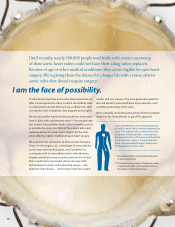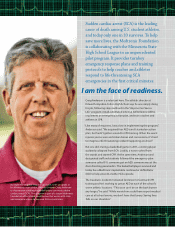Medtronic 2011 Annual Report Download - page 17
Download and view the complete annual report
Please find page 17 of the 2011 Medtronic annual report below. You can navigate through the pages in the report by either clicking on the pages listed below, or by using the keyword search tool below to find specific information within the annual report.
13
For decades, health care practitioners were taught that, in many cases, giving
blood to a patient was a good thing. But recent studies and publications
have shown that blood transfusions can result in costly and even fatal
complications. In response, medical societies have issued guidelines for
limiting blood product use in cardiac surgeries. Following the guidelines can
be a daunting task for hospitals, so we’re helping them through an innovative
program called the Rethinking Blood Conservation (RBC) Initiative.
Our RBC Initiative professionals educate and support
hospital administrators and surgical teams as they
implement a multi-pronged approach to blood
conservation during cardiac surgeries — which have,
historically, consumed up to 20 percent of the United
States’ blood supply. We support our hospital partners
as they incorporate any or all of the following blood
conservation tactics:
Benchmarking and other measurement tools used by
hospitals to assess the patient and nancial impact of
blood conservation eorts.
Training and education programs to increase
awareness of societal guidelines and recommended
clinical practices.
Devices that wash the patient’s blood during
cardiac surgeries.
Technologies that protect the patient’s blood from the
stress of an operation, including a device that acts as
the patient’s heart during surgery.
We believe that by helping hospitals improve blood
management during cardiac surgeries, we can help
them positively impact patient outcomes.1
One example is St. Joseph’s Hospital in St. Paul, Minnesota,
which started a bloodless surgery program in early
2011. The hospital has implemented several changes
in techniques and products, including the Medtronic
Resting Heart System, which supports the patient’s heart
and lungs during surgery. The program is designed to
reduce the need for blood transfusion and minimize
blood contact with foreign surfaces, thereby lowering
the risk of inammation.
“We worked closely with Medtronic representatives
to adapt the machine to our needs, and they helped
educate our surgical team on the complexities of the
system,” said Dr. Robert Emery, Medical Director of
Cardiovascular Surgery at St. Joseph’s. “As a result of
our various blood management eorts, our average
per-procedure transfused blood use went from
80percent to 20 percent within ve months.”
Dr. Emery is also sharing his experience with other
hospitals in an eort to change conventional thinking.
“We were all trained to think that giving transfused blood
to a patient was a good thing. Now there’s an eort to
reduce the use of blood, but we need to change that
thinking, too, “ he said. “We need to eliminate the use of
blood during surgery — period.”
1 Ranucci R, Giuseppe I. Minimally invasive cardiopulmonary bypass: does it really change
the outcome? Critical Care. 2007;11:R45
I am the face of accountable health care.
























